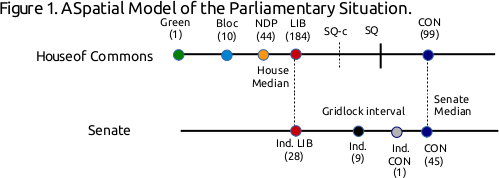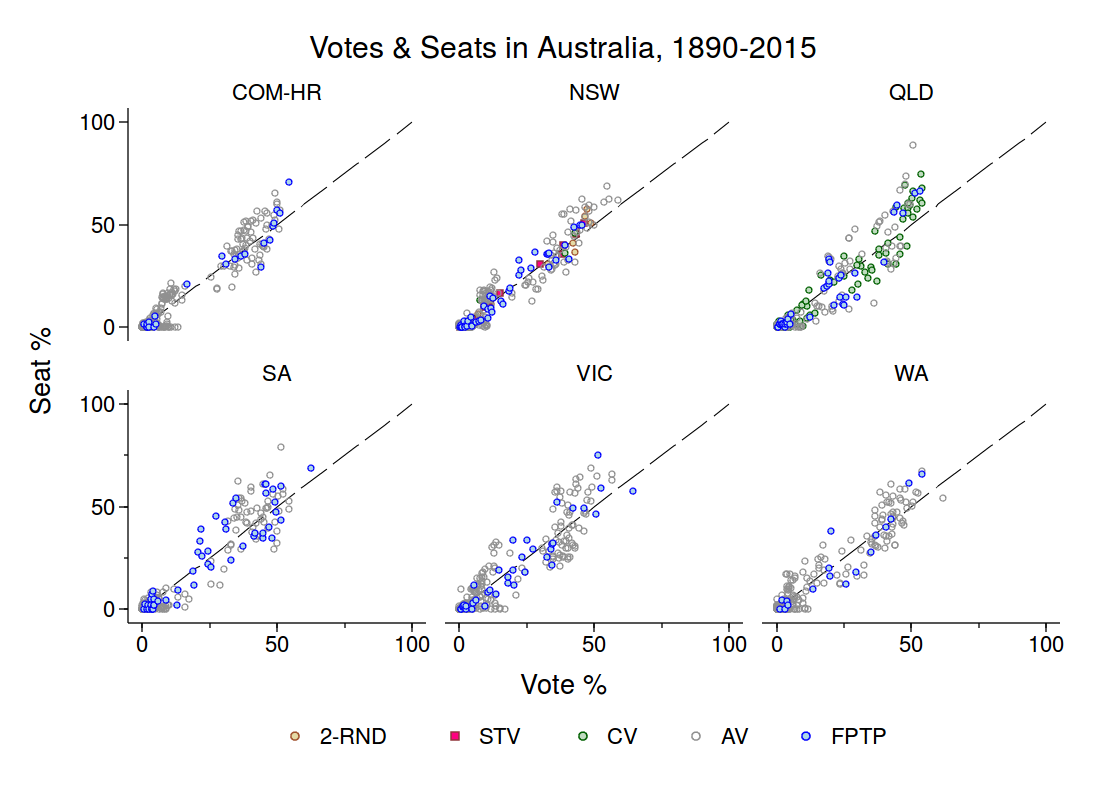It’s been a long time since I wrote a blog post, but impetus has come in the form of Jenny Kwan’s latest “10-percenter”*. (Kwan – unfortunately for me – is the MP for Vancouver East, where I live.) The 10-percenter is on electoral reform, and specifically on the virtues of PR. That’s both understandable and logical given that Kwan sits for the NDP: the NDP bear the brunt of our SMP system’s disproportionality and would likely see their seat share and policy influence increase under PR. If you are an NDP supporter, you ought to support PR on that basis: it’s in your political interest.
Kwan’s pamphlet doesn’t make that kind of straightforward argument, however. Instead, it offers up a rather incoherent and biased comparison of the current electoral system (single-member plurality) and PR. Here’s the full text of Kwan’s pamphlet; I’ve highlighted areas that I examine in greater detail below:
Defenders of the status-quo will likely tell you that proportional voting systems lead to chaos – with endless elections and instability. But the reality is the exact opposite is true.
Canada already has a lot of federal elections. In fact, we’ve had 22 in total since 1945. That makes us more “unstable” than Italy, a country that uses proportional representation and has had just 18 elections over the same period.
Proportional elections eliminate “false majorities” by ensuring no party gets a higher percentage of seats than their percentage of votes. That forces political parties to work together and deliver results in a stable coalition government.
Beyond making our elections fairer and more stable, proportional systems have many other positive impacts on the countries that use them. For example, they tend to have stronger economies with higher surpluses, lower deficits, and less debt.
Countries where parties work together collaboratively are also more likely to tackle two of the biggest issues of our time: climate change and income inequality.
With consultations on democratic reform underway, we have a once in a lifetime opportunity to build a better Canada with fairer elections. We have to get it right.
Let’s start with the incoherent aspects of this argument. The first claim here – if I follow – is that elections are finite in occurrence under PR; that is the exact opposite of “endless elections” is it not? Speaking as a person who prefers to live in a democracy, let me say that I really hope that elections are endless! I guess the question that Kwan’s constituents should pose to her is when will elections end under PR, after one election or two?
The second puzzling aspect of the argument is the comparison that Kwan draws between politically “unstable” Canada and politically stable Italy. Huh?! It’s not only that the data that Kwan presents on this front are highly misleading (see below), but that Italy is precisely the wrong country to bring up when trying to establish that PR’s does not imply political instability. I could see bringing up Austria or Germany or Sweden…. but Italy??
To see how misleading Kwan’s comparison is one needs to appreciate that the metric of political stability in the electoral systems literature (see, e.g., Powell (1982), Lijphart (1999), Farrell (2001, 193)) is not the frequency of elections but cabinet duration. One good reason for this is that the time between mandated elections varies substantially across countries; it’s just 3 years in Australia, for example. Indeed, if I crack open my Stata and upload a data set on elections and cabinets in OECD countries from 1945 onward I find that Australia’s had 27 elections since 1945. Do you think that Australia’s been the least stable OECD country over the post-war period? Me, neither.
So let’s consider how Canada and Italy perform in terms of cabinet stability over the post-war period. (A caveat here is that my data are not well configured to estimate cabinet longevity because they are formatted by election not by cabinet, and while I am exercised by Kwan’s distortions, I’m not so exercised that I’m going to take 45 minutes to reformat my data set). Bearing that caveat in mind, my data (all publicly available on ParlGov) do allow me to present two metrics of cabinet stability:
- the average number of cabinets per year, and
- the average duration of the initial cabinet, i.e., the cabinet first installed after a general election
My data on Canada cover 70 years, from June 1945 – November 2015.
- In that period, Canada was governed by 27 cabinets, for an average of .39 cabinets per year.
- In Canada, initial cabinets (and there’s never been more than 3 in any parliamentary term) have survived an average of 1116 days. This is 61 percent of the maximum time period of 5 years between Canadian elections.
My data on Italy cover 66 years from May 1948 – February 2014.
- In that period, Italy was governed by 62 cabinets, for an average of .94 cabinets per year.
- In Italy, initial cabinets (and Italy’s averaged 3.65 per parliamentary term) have survived an average of 524 days. This is 30 percent of the maximum time period of 5 years between Italian elections.**
The difference here is stark. Italian cabinets have been less than half as durable as Canadian cabinets over the post-war period. Thus Kwan’s claim that Italy has had fewer elections than Canada in this period is true, but it’s also incredibly misleading as to which country’s had the more stable governments. (An irony here is that Kwan’s district includes Vancouver’s traditional Italian neighborhood, and so many of her constituents will know exactly what a political basket-case Italy is.)
Now one can certainly debate whether cabinet durability is an informative normative metric; Lijphart (1999), for example, argues that cabinet durability is not necessarily a good indicator of policy-making effectiveness. And we can have too much durability – ossification – as well as too little. But that’s a different argument.
Let me move on to the old “false majority” chestnut. (This critique of SMP just won’t go away – sigh.) It is true that plurality electoral systems occasionally produce elections in which the 2nd-place party in terms of vote share wins the plurality of seats. Note that this is a system-level not a district-level phenomenon. In each district, it’s the candidate with most votes who wins. However, a party’s vote share can be spread in a very inefficient fashion across seats (large majorities in a minority of districts) such that it secures a large vote share but a small seat share. It’s hard – but not impossible – to generate similar distortions under PR; the key is to have a small district magnitude (and many districts) as in Chile’s “binomial” electoral system.
More to the point, PR can easily produce another kind of “false majority”. Imagine that an electorate is comprised of three types of voters with preferences over 3 parties, a, b and c as shown in the table below. Thus voters of Type A prefer party a first, b, second, and c, third. Let’s say that there’s a rough equality between types of voters (so 33% of each), and that they vote sincerely. Thus, parties a, b and c gain roughly equal shares of votes and seats, the electoral system being highly proportional. All parties have equal legislative power under these conditions, and any two can form a majority coalition. Let’s say that a and b form a coalition.
|
Voter Type |
|||
|
A |
B |
C |
|
| 1st preference |
a |
b |
c |
| 2nd preference |
c |
c |
a |
| 3rd preference |
b |
a |
b |
Now, on one hand, a coalition of a and b can claim to enjoy the support of a majority because, 2/3 of voters voted for either a or b. On the other hand, the electorate was not presented with a choice over all possible outcomes; they got to vote only for a or b or c – not a coalition of a & b, b & c, or a & c. If voters had been given such a choice, a majority might well have voted for a coalition of a & c given that all a-types prefer a and a & c to b and all c-types prefer c and c & a to b. On this basis, one could argue that the coalition of a and b reflects a “false majority”.
There are two points here:
- “False majorities” do not disappear under PR; they just take on a different and less obvious form; these “false majorities’ are not at all inevitable, but they cannot be ruled out ex ante;
- Using the concept of a “false majority” to evaluate an electoral system is a dead-end.
I can expand on the second point: One of the central messages of social choice theory is that it’s almost never possible to identify if there exists a coherent and uncontradicted majority in favour of a particular policy or outcome (save in the case of a majority vote over two alternatives). The problem (as I have written and spoken about again… and again… and again) is that the electorate is better understood as an agglomeration of multiple, partly conflicting majorities. The idea is pretty simple: sure, there may exist a majority for policy X and also one for policy Y – but it does not follow that there necessarily exists a majority in favour of both X and Y.
The rest of the claim is no better. The statement that proportional representation “ensur[es] no party gets a higher percentage of seats than their percentage of votes” is not wholly accurate. As Douglas Rae (1967, 134) observed “The prejudice of electoral laws – and here I include even the P.R. systems (my emphasis) – in favor of strong elective parties and against weak ones is very nearly a universal fact of life.”(By strong parties, Rae meant those polling more than 20 percent.)
The reason this occurs is due to a variety of factors; the two main ones are a finite, and typically quite low district magnitude in most electoral systems, and electoral thresholds. If the district magnitude is below 5 or 6 and the electoral threshold in the neighborhood of 5 percent, it’s quite possible for a PR system to deviate significantly from proportionality – and this deviation always favours larger parties. (Certain quotas – like the Imperiali quota — also systematically favour larger parties.)
The last part of the claim, that proportionality “forces political parties to work together and deliver results in a stable coalition government” is not so much false as it is contingent. Certainly, cooperative, stable coalition government is one possible outcome of a PR electoral system; that’s largely the German, Austrian, and Dutch experience.Two other alternative outcomes are possible and widely observed, however.
The first alternative is what Giovanni Sartori (1976) termed polarized pluralism: a pattern of party fragmentation, unstable coalition governments, and policy immobility. This is the French 4th Republic, Italian, Belgian and Israeli experience. The second alternative is minority government; this is Swedish, Norwegian and Danish experience (see Strom 1990).
I actually think this second alternative is the most likely outcome in the Canadian case were we to adopt PR. The fact that Canadian opposition parties have allowed minority governments to form and last indicates that there are significant (unobserved) costs to joining a government and/or bringing down a government in Canada, and possibly significant (unobserved) benefits to being in opposition; else opposition parties would have forced our minority governments into coalition or brought them down immediately. In addition, the structure of the party system facilitates minority government. Let’s say that the Liberals get a plurality of seats under PR and the NDP says “let’s make a coalition.” The Liberals can tell the NDP (and Greens) to go pound sand. What are the NDP going to do? Bring down the Liberals in favour of the Tories or a new election? PR may deliver different seat shares to the smaller parties, but unless the configuration of the party system also changes substantially, it will not necessarily increase their legislative power.
Moving on to our unfair and unstable elections… (Are Canadian elections unstable, marked by widespread violence and irregularities? Perhaps in the 1870s…. but nowadays?) The claim here is that countries that use PR have “stronger economies with higher surpluses, lower deficits, and less debt.”
I am not sure where Kwan gets the statistics to back this statement up because the debate on the macroeconomic effects of electoral systems is far from settled. Lijphart (1999) made similar statements about the superiority of consensus democracies (which use PR) in Chs. 15 and 16 of “Patterns of Democracy”, and in his 1997 EJPR piece he declared: “the results of statistical analysis were clear and almost completely unequivocal. . . Over-all, consensus democracy is superior to majoritarian democracy. I have no second thoughts about these conclusions.”
Lijphart’s evidence was not particularly strong, however; it consisted mainly of a series of bivariate regressions on data up to the 1980s. When Anderson (2001) re-analyzed these data he found that the superior macro-economic performance of consensus democracies disappeared once one controlled for corporatism and central bank independence. In fact, controlling for these two factors (which are not themselves due to the electoral system), Anderson found that consensus democracies had higher rates of inflation and unemployment than majoritarian democracies. These results are consistent with work by Rogowski and Kayser (2002) that finds that price levels are higher in PR systems. Related work by Bawn and Rosenbluth (2006) finds that government spending grows in line with the number of parties in government. That said, Iversen and Soskice find systematically less economic inequality under PR.
The reality is that one could line up literature on both sides of the claim that PR is good / bad for the economy. My own view is that the electoral system probably has only a small effect on economic outcomes. Other, more fundamental institutions – the rule of law, constitutional limitations on government – probably have a greater impact in the sense that for a society that gets these fundamentals right the electoral system probably doesn’t really matter much. Conversely, get these fundamentals wrong, and changing the electoral system is unlikely to make a damn bit of difference.
* A “10-percenter” is a newsletter that an MP can send to 10% of her constituents on the federal government’s dime.
**OK, so these are not median survival times from a well-specified Cox Proportional Hazards model, and as such they may suffer from right-censoring. BUT 1) any right-censoring probably understates just how much more stable Canadian cabinets have been relative to Italian cabinets, and 2) this blog is not intended to be a statistics symposium, in any case.

 Follow
Follow



